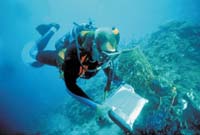Clifton explores algal reproduction on coral reefs

“Suddenly, I saw the reef begin to smoke,” Clifton says. “Plumes of green were pouring out of the seaweed on the reef. The water around me turned bright green. The seaweeds became paler and paler. Within 10 minutes, it was over. By the time the water cleared, the seaweeds were dead.
“I was stunned. In the 20 years that I had been working as a biologist, I had never seen anything like this. I thought, ‘Either there is something toxic in the water, or I am watching a sexual event.’”
Clifton, assistant professor of biology at Lewis & Clark College, had just witnessed several hundred green algae releasing their gametes—eggs and sperm—en masse into the water column.
“It was a remarkable moment,” he recalls. “I saw something that no one else had ever reported.”
Clifton’s early morning observation off the coast of Panama put him at the forefront of an entirely new area of research and prompted a systematic, multifaceted study of algae and their reproductive tactics.
“I can’t overstate how important seaweeds are in coral reef ecology,” he says.
Tropical seaweeds, such as Neptune’s shaving brush (Penicillus) and mermaid’s sea fan (Udotea), are common on coral reefs.
“With their relatively large size and abundant distributions, these calcified green algae have long been recognized as an important source of food, shelter, competition and sediment within
reef and seagrass communities.”
After several years of intensive underwater field study with funding from the Smithsonian Institute and National Geographic Society, Clifton learned to recognize the changes in color, form and structure that are related to various stages of sexual development for 28 species of green algae from five genera.
His careful observations revealed that reproduction involves the rapid expulsion of gametes into the water column, followed by immediate death. Moreover, he discovered that seaweeds use the rising sun as a cue to release their gametes.
“Timing is everything,” Clifton notes. “Synchronous gamete release among neighbors boosts the concentration of eggs and sperm, which increases the likelihood that gametes from different individuals will meet.”
He discovered that fertile plants release their gametes within seconds of one another and that each species has a specific time of gamete release. Gamete size, motility and behavior also vary between species, he reports.
His observations, published in Science, Science News and Earth magazine in 1997 and in other publications throughout the world, provided marine scientists with the first intimate details of a seaweed’s sex life.
Last year, Clifton’s paper “The Phenology of Sexual Reproduction by Tropical Green Algae,” published in the Journal of Phycology (1999), was a finalist for paper of the year by the Phycological Society of America.
This past fall, he received a three-year grant totaling $167,000 from the National Science Foundation to continue his research with the help of Lewis & Clark students.
He’ll continue to study the effect of reproductive events on coral reef ecology.
“Because seaweeds die after sex, large tracts of previously overgrown reef are typically exposed following major reproduction events. This may be good news for other marine organisms as they cast about for a foothold on the crowded reef bottom,” Clifton says.
-text by Jean Kempe-Ware, photo above by George Steinmetz
More L&C Magazine Stories
Lewis & Clark Magazine is located in McAfee on the Undergraduate Campus.
MSC: 19
email magazine@lclark.edu
voice 503-768-7970
fax 503-768-7969
The L&C Magazine staff welcomes letters and emails from readers about topics covered in the magazine. Correspondence must include your name and location and may be edited.
Lewis & Clark Magazine
Lewis & Clark
615 S. Palatine Hill Road MSC 19
Portland OR 97219

